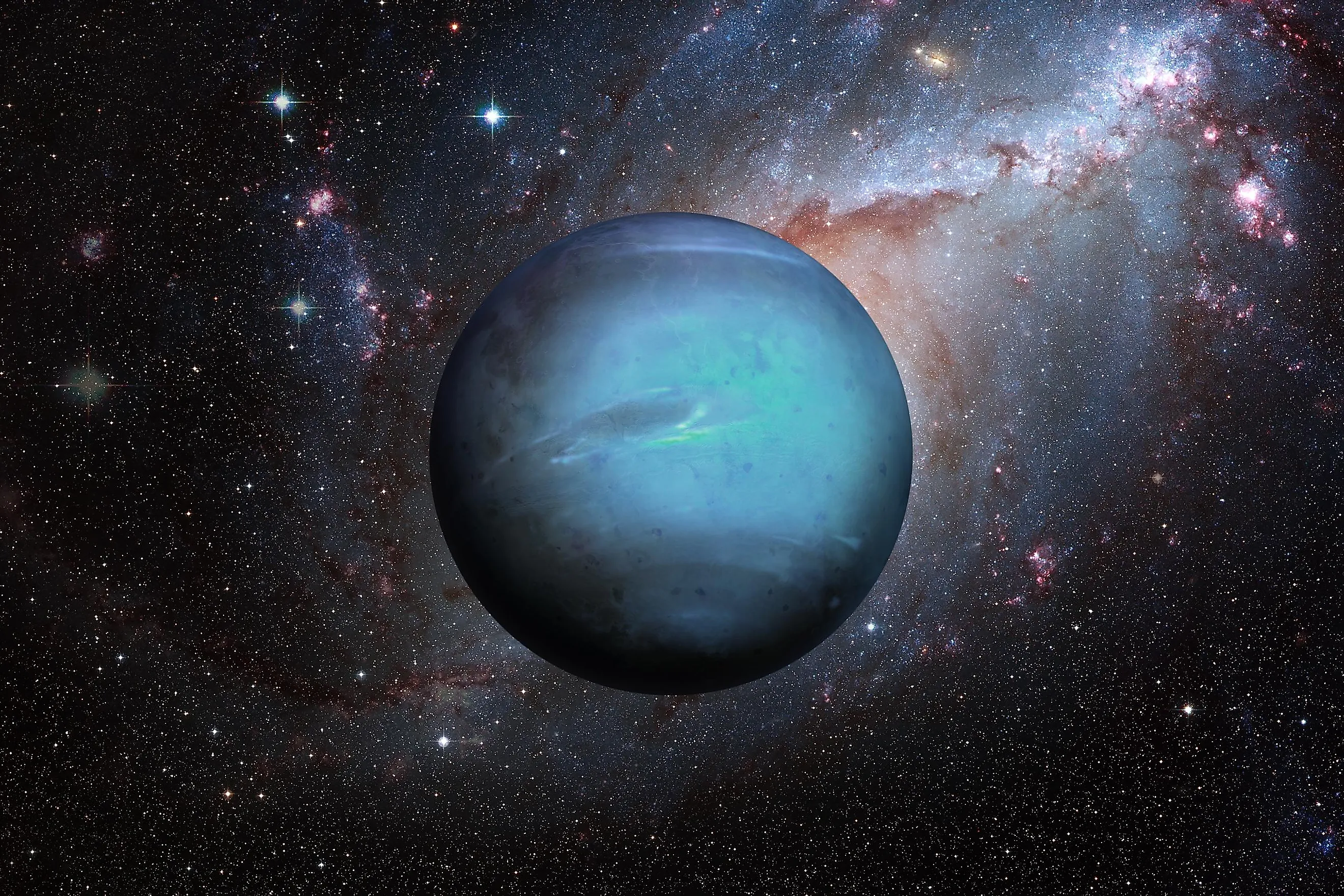
Neptune
Orbiting the sun at a distance of 2.8 billion miles (4.5 billion kilometers), Neptune is the fourth-largest planet by diameter and third-largest by mass, having a diameter of 30,598 miles (49,244 kilometers). Strangely, it is slightly more massive than Uranus, which is strange given that the mass of the gas giants should increase the closer you get to the sun. This has led astronomers to predict that Neptune may have formed much closer to the sun than Uranus did. Still, gravitational perturbations from the other gas giants caused its orbit to migrate outwards. In the 174 years since astronomers found Neptune, it has only been visited by a spacecraft on a single occasion, when Voyager 2 passed by the giant planet in 1989. Voyager 2 revealed a truly remarkable and complex world. Neptune is a warmer planet despite it being further from the sun than Uranus. The core of Neptune is predicted to reach temperatures of (7,000 degrees Celsius), while its upper layers reach temperatures as low as minus 328 degrees Fahrenheit (minus 200 degrees Celsius). This gigantic difference in temperature between Neptune's outer and inner layers is believed to cause Neptune's dynamic weather system. Voyager 2 measured the fastest known winds in the solar system, reaching speeds of 1,500 miles per hour (2,400 km/h).
Although classified as gas giants, both Uranus and Neptune have enough unique characteristics that they belong to their own classification: ice giants. Unlike Jupiter and Saturn, Uranus and Neptune contain a much higher abundance of ices, such as water, ammonia, and methane. Like Jupiter and Saturn, Neptune is composed mainly of hydrogen and helium. However, hydrogen and helium only make up a fraction of Neptune's density. Various ices determine the density of Neptune, making it both a gas giant and an ice giant.
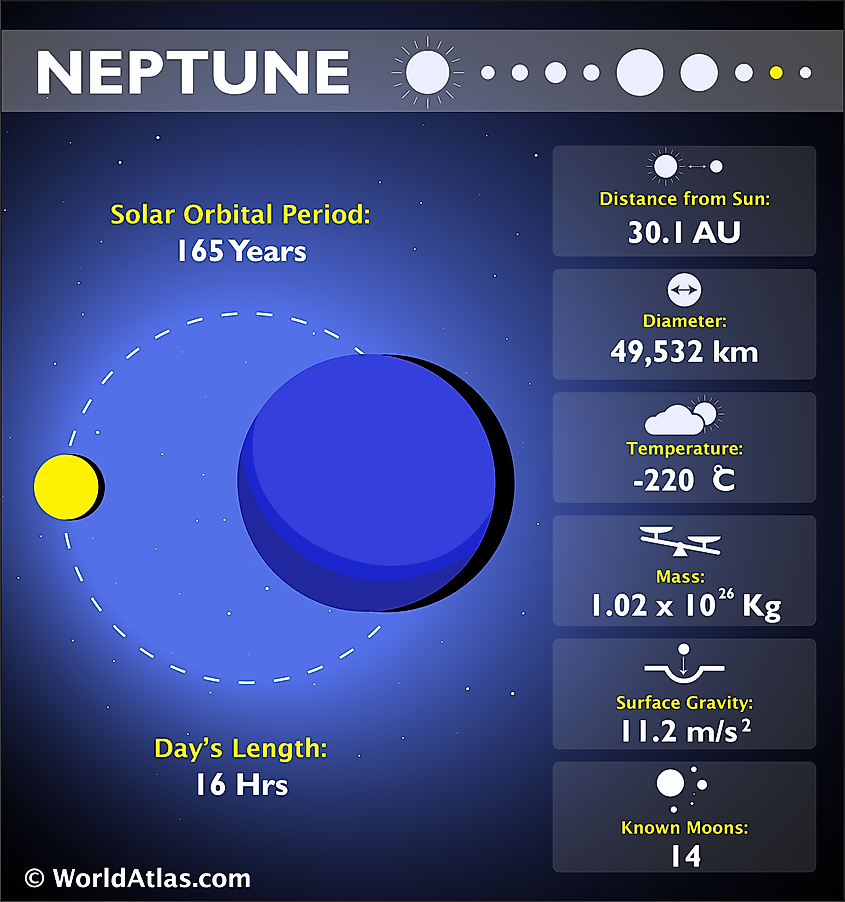
Observational History

Neptune was the latest planet to be discovered in our solar system and, interestingly, the only one to be found using mathematics rather than a telescope. The discovery of Neptune was tied directly to the discovery of Uranus. In 1781, the astronomer William Herschel discovered the planet Uranus. After the discovery of Uranus, astronomers were puzzled over its orbit. The orbit of Uranus was tilted so that the mass of Uranus and the gravitational pull of the sun could not explain. In 1821, Alexis Bouvard predicted that the orbit of Uranus could be explained if another planet was orbiting the sun outside of Uranus's orbit. He was able to predict the orbit of this eighth planet, and in 1846, astronomers pointed their telescopes to the sky and found Neptune, just as the math had predicted. Given Neptune's distance from us, it is not an easy world to study. For over a hundred years, virtually nothing was known about Neptune. Astronomers would not get their first up-close view of Neptune until 1989 when the Voyager 2 spacecraft completed the first-ever flyby of Neptune. To date, the Voyager 2 flyby has been the only mission to Neptune, and it raised far more questions than it answered. Neptune is one of the most mysterious worlds in the solar system, and our knowledge of it is definitely lacking. However, as telescopes have become more powerful, astronomers have observed Neptune in more detail than in the past. Still, most of what is known about Neptune comes from the Voyager 2 flyby.
Orbit And Rotation
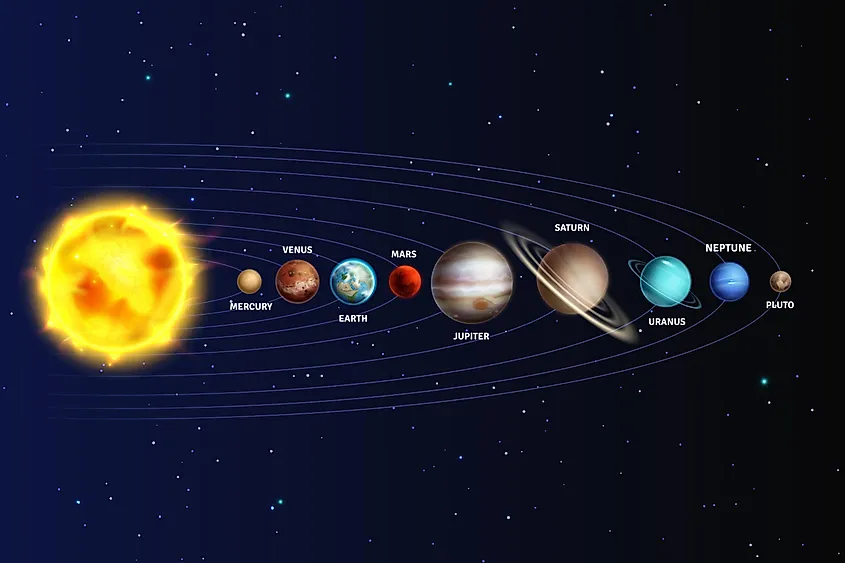
The average distance between Neptune and the sun is 2.8 billion miles (4.5 billion kilometers). It takes Neptune nearly 170 Earth years to complete one orbit around the sun at such a vast distance. Since its discovery, Neptune has only completed one full sun rotation. Like all the other planets, Neptune orbits the sun in an ellipse, meaning that the distance between the sun and Neptune changes through the planet's orbit. Neptune is roughly 2.76 billion miles (4.45 billion kilometers) away from the sun during its closest approach. Neptune is 2.81 billion miles (4.53 billion kilometers) away from the sun during its furthest approach.
Neptune's orbit and location in the solar system have a profound impact on the solar system's outer regions. Just beyond the orbit of Neptune is the Kuiper Belt, a vast collection of comets and other forms of planetary debris. Short-period comets primarily come from the Kuiper Belt, and it is the gravitational pull of Neptune that generally pulls them on a trajectory towards the inner solar system.
As a gas giant, Neptune has an interesting rotation. The axis tilt of Neptune is only 28 degrees, which is quite similar to Earth's 23 degrees. As a result, Neptune experiences seasonal changes similar to Earth's, the significant difference being their length. Since it takes Neptune 170 years to orbit the sun, its seasons generally last up to 40 Earth years. Since Neptune is primarily composed of gas, Neptune's atmosphere rotates at a different rate than the planet itself. The actual rotation of a gas giant is generally determined by the rotation of the planet's magnetic field. Neptune takes roughly 16 hours for the planet to rotate once about its axis. Along Neptune's equator, it takes the atmosphere 18 years to rotate around the planet. In the polar regions, it takes 12 hours. This difference in rotation is one factor contributing to Neptune's high wind speeds.
Neptune’s Atmosphere
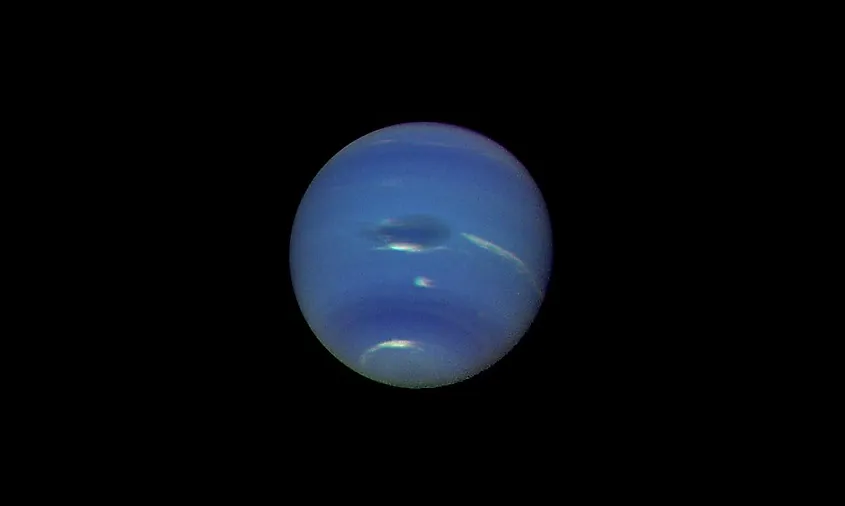
The atmosphere of Neptune is similar to that of Uranus and the other gas giants. Neptune's atmosphere is about 80% hydrogen and 19% helium in its upper layers. The remaining 1% is composed of various ices, the most notable of which is methane. On Uranus, methane in the upper atmosphere absorbs incoming red light and scatters blue light, causing Uranus to be cyan-green. Neptune contains a similar amount of methane as Uranus, which is one reason why Neptune is blue. However, based on what is currently known, Neptune should be the same color as Uranus, yet Neptune is a much deeper blue than its planetary neighbor. As of yet, scientists do not know all the factors that contribute to Neptune's color.
The atmosphere of Neptune can be divided into two central regions: the troposphere and the stratosphere. The troposphere composes the lower regions of Neptune's atmosphere, while the stratosphere composes the upper areas. In the troposphere, temperatures increase with altitude. In the stratosphere, the opposite occurs, and temperatures decrease with altitude. Temperatures between the troposphere and stratosphere vary wildly. In the troposphere, temperatures average around 32 degrees Fahrenheit (Zero degrees Celsius), while temperatures in the upper stratosphere drop as low as minus 328 degrees Fahrenheit (minus 200 degrees Celsius). The troposphere is characterized by an abundance of clouds that can form at higher temperatures. Clouds in the troposphere are primarily made of methane, ammonia, and hydrogen sulfide. The troposphere is also where most of Neptune's weather occurs.
Neptune is home to the fastest recorded winds in the solar system. Voyager 2 recorded wind speeds of over 1,500 miles per hour (2,400 km/h), which happens to be faster than the speed of sound on Earth. If Neptune's winds were to occur in Earth's atmosphere, they would be supersonic winds. Interestingly, since air is the medium that sound travels through, the sound speed depends on the density of air. Air density on Neptune is far higher than on Earth, so winds do not exceed the speed of sound on Neptune.
Internal Structure Of Neptune
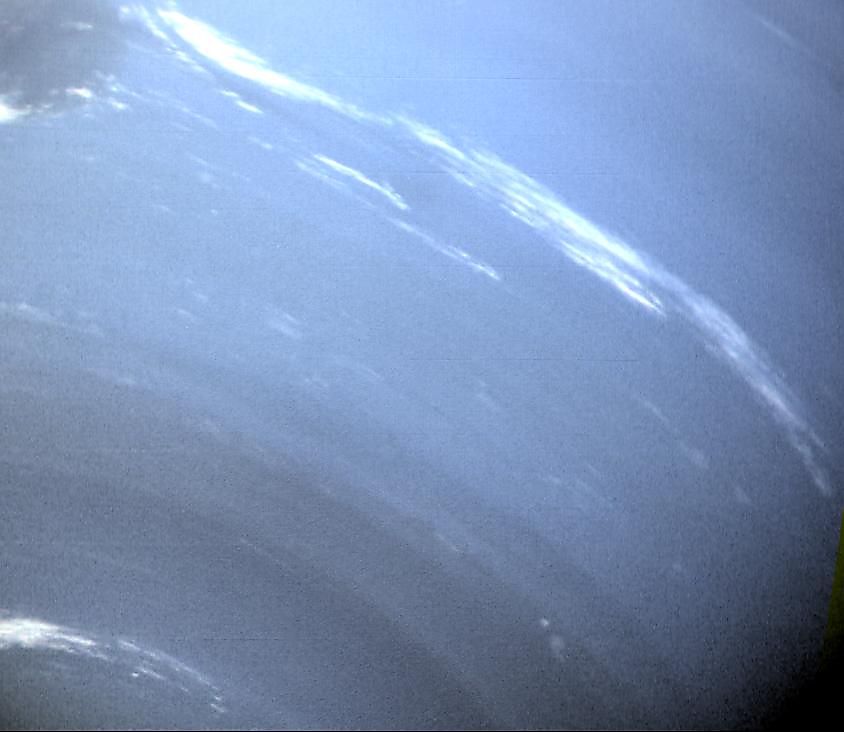
Neptune's atmosphere composes an estimated 10% to 20% of the distance to Neptune's core and only about 5% of the planet's total mass. Below the atmosphere is a world, unlike anything we are familiar with on Earth. At the very bottom of Neptune's atmosphere, pressures are 100,000 times larger than on Earth. Below the atmosphere is the mantle. On Earth, the mantle is composed mostly of molten rock. On Neptune, the mantle is comprised of various ices such as methane, water, and ammonia. At a depth of around 4,350 miles (7,000 kilometers), pressures and temperatures in the mantle become so extreme that the carbon atoms in methane molecules break apart and form into diamond, which then proceeds to fall through the mantle as a kind of diamond rain. There may even be an ocean of liquid carbon in the lower mantle, where giant diamond bergs float freely.
Below the mantle is the core of Neptune. The core of Neptune is largely a mystery, and so scientists rely on models to predict what may be occurring there. It is assumed that the core of Neptune is rocky, composed mostly of metal and silicate rock. The core itself is likely larger than the Earth and has a mass of around 1.2 Earths. Temperatures are estimated to reach as high as 9,260 degrees Fahrenheit (5,126 degrees Celsius).
Neptune's Moons
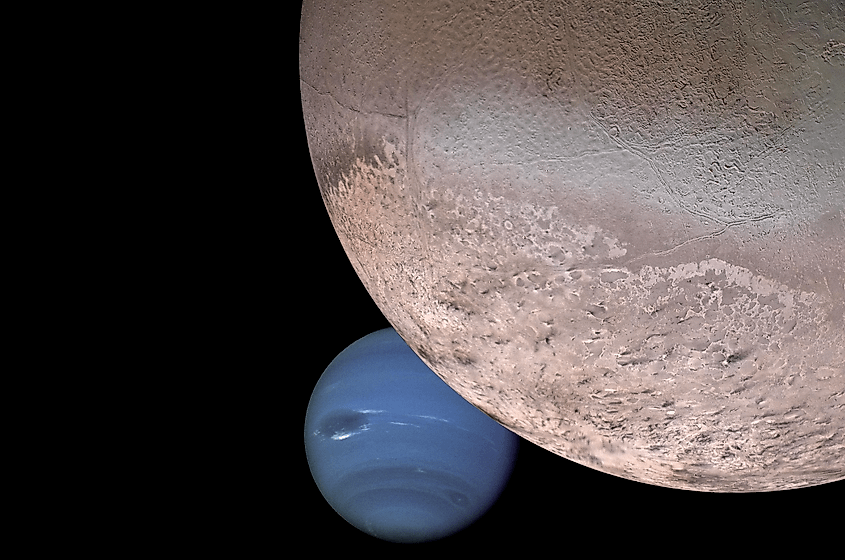
Neptune is orbited by 14 known moons. Of those 14 moons, only one, called Triton, is large enough to be spherical. Triton comprises roughly 99% of the total mass of Neptune's entire moon system. Triton has a diameter of 1,680 miles (2,710 kilometers), making it the seventh-largest moon in the solar system. Triton was discovered only 17 days after the discovery of Neptune, yet not much was known about this moon until the Voyager 2 flyby of Neptune. Triton has become one of the strangest, most interesting moons in the solar system. Unlike every other moon, the orbit of Triton is retrograde, meaning it orbits in the opposite direction of Neptune's rotation. This suggests that Triton never actually formed in orbit around Neptune. Instead, Triton was likely a dwarf planet that formed in the Kuiper Belt and just happened to get caught in Neptune's gravity. Although the retrograde motion of Triton may not sound significant, it has actually doomed this moon. The orbit of Triton is slowly degrading, and Triton is currently spiraling towards Neptune. In about 3.6 billion years, Triton will be so close to Neptune that it will be ripped apart by Neptune's gravity.
When Voyager 2 approached Triton in 1989, it recorded the coldest measured temperature in the solar system. The surface of Triton drops to a frigid minus 391 degrees Fahrenheit (minus 235 degrees Celsius). Voyager 2 found clear evidence of geologic activity on Triton despite these cold temperatures. Voyager 2 found evidence of volcanism and tectonic activity and a lack of impact craters. Unfortunately, Voyager 2 was only able to map 40% of Triton's surface, so Triton is one of the most mysterious worlds in the solar system.
Neptune Fact Sheet
| Diameter | 30,598 miles (49,244 kilometres) |
|---|---|
|
Mass |
17 Earths |
|
Moons |
14 |
|
Rings |
5 |
|
Distance from the sun |
2.8 billion miles (4.5 billion kilometers) |
|
Length of year |
170 Earth years |
|
Length of day |
16 hours |
|
Surface temperature |
minus 328 degrees Fahrenheit (minus 200 degrees Fahrenheit) |
|
Atmospheric composition |
80% hydrogen, 19% helium, 1% methane |
|
Surface composition |
Water, methane, ammonia, silicate rock |
|
Discovery date |
September 23, 1846 |
|
Discovered by |
Urbain Le Verrier |











